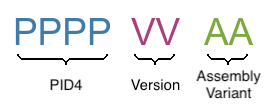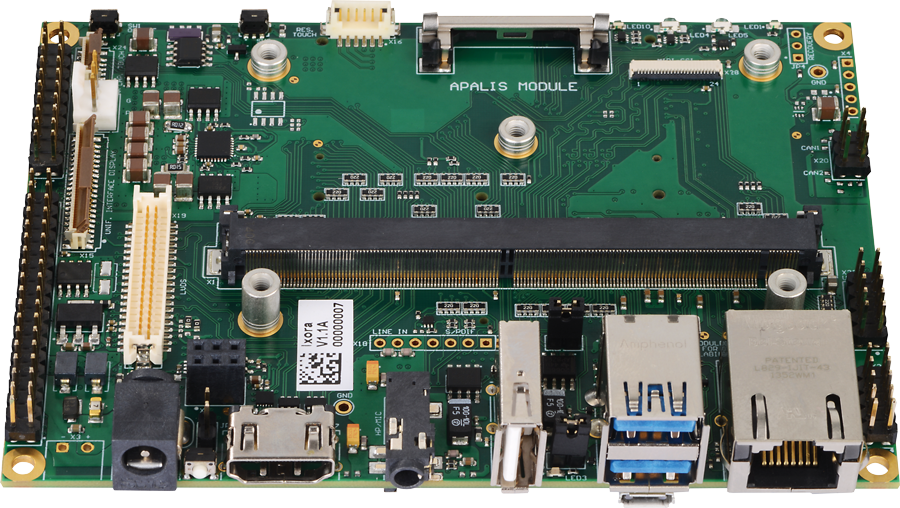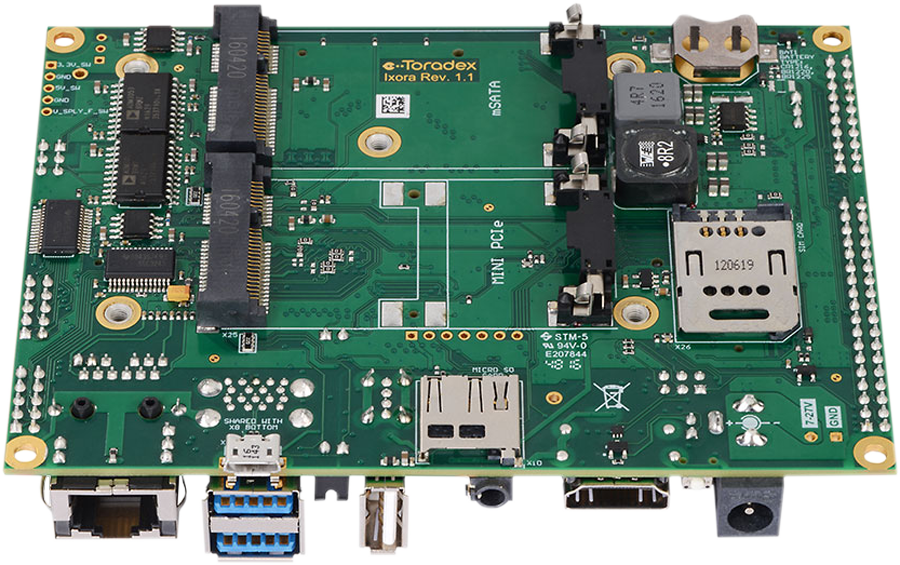Ixora Carrier Board
Getting Started
This section contains initial information needed to set-up the Ixora Carrier Board for the first time.
Recommendation for a first-time order
Toradex recommends ordering the following additional products for your first-time order:
All the products can be ordered online at Toradex Webshop
Getting started for the first time?
For detailed step-by-step instructions about how to start with both, SoM and Carrier Board, please have a look at our step-by-step Getting-Started Guide:
Product-specific information for the Ixora Carrier Board:
Having trouble?
Please contact our technical support. Various option of technical support are mentioned in the article below.
Features
I/O Support
- USB 2.0 (1x Host, 1x OTG )
- USB 3.0 (2x Host)
- PCIe (1x Mini PCIe)
- I2C (2x)
- SPI (1x)
- UART (3x RS232)
- PWM (4x)
- GPIO (up to 40)
- Analog Input (4x)
- Ethernet (1x 10/100/1000 Mbit)
- SATA (1x mSATA)
- SDIO/SD/MMC (1x 4 Bit MicroSD)
- CAN (2x)
- LVDS (1x Dual Channel)
- S/PDIF In/Out (1x)
- HDMI (1x)
- RGB (1x 24 Bit)
- Resistive Touch (4/5-wire)
- Capacitive Touch connector
- Camera Parallel Interface (1x)
- Camera Serial Interface (1x)
- Analog Audio Line in (1x)
- Analog Audio Mic in (1x)
- Analog Audio Headphone out (1x)
- RTC on Board (1x)
Block Diagram

Datasheets
Ixora V1.3 datasheetIxora V1.2 datasheet
Ixora V1.1 datasheet
Ixora V1.0 datasheet
Design Resources
Design data Ixora Carrier Board V1.3
Design data Ixora Carrier Board V1.2
Design data Ixora Carrier Board V1.1
Design data Ixora Carrier Board Archive
Ixora Carrier Board Mechanical Models
A basic 3D model for the Ixora Carrier Board V1.3 can be downloaded here:
- SolidWorks CAD model 3D EASM model
- You can download the free eDrawings model viewer from SolidWorks here
- 3D STEP model that can be opened and modified in any 3D CAD
- 3D PDF model that can be opened in Adobe Reader
Ixora Carrier Board V1.2 Models
- SolidWorks CAD model 3D EASM model
- You can download the free eDrawings model viewer from SolidWorks here
- 3D STEP model that can be opened and modified in any 3D CAD
- 3D PDF model that can be opened in Adobe Reader
Ixora Carrier Board V1.1 Models
- SolidWorks CAD model 3D EASM model
- You can download the free eDrawings model viewer from SolidWorks here
- 3D STEP model that can be opened and modified in any 3D CAD
- 3D PDF model that can be opened in Adobe Reader
Ixora Carrier Board V1.0 Models
- SolidWorks CAD model 3D EASM model
- You can download the free eDrawings model viewer from SolidWorks here
- 3D STEP model that can be opened and modified in any 3D CAD
- 3D PDF model that can be opened in Adobe Reader
Design and Layout Guide
Altium Designer
Compatible Products
- Apalis iMX8
- Apalis iMX8X
- Apalis T30
- Apalis TK1
- Apalis iMX6
- Apalis Heatsink
- Carrier Board Accessory Kit
- Apalis iMX6 Mezzanine
- Apalis T30 Mezzanine
- Analogue Camera Adapter
- Capacitive Touch Display 7" Parallel [1]
- Resistive Touch Display 7" Parallel
- Capacitive Touch Display 10.1" LVDS
- EDT Display
- LM816 USB WiFi
- CSI Camera Module 5MP OV5640 - for Ixora V1.1A and newer
[1] For Ixora V1.0A Capacitive Touch Adapter is required, V1.1A or above are directly compatible.
Revision History
Click to See the Product Numbering Scheme
Product Number (PID8) Format
The format of the 8-digits Product Number (PID8) is the following:

The below table describes the structure of the Product Number (PID8):
| Field | Description |
|---|---|
| PPPP | 4-digits number, indicating the Product Configuration (PID4) that describes the key properties of the product (e.g. Product Group, RAM capacity, etc.) |
| VV | 2-digits number, indicating the Major and Minor Version (in that order) |
| AA | 2-digits number, indicating the Assembly Variant |
See the complete list of available combinations on the Revision History table of the corresponding product page.
Example
Product number (PID8): 00291100:
0029: Apalis iMX6D 512MB11: Major Version 1, Minor Version 1, Version V1.1 in short
00: Assembly Variant A
A specific product revision has a lifecycle defined by the product state. Learn more about it on the Product Change Notifications.
Ixora Carrier Board
PN: 0133
| Product # | Product Description | Changes from Previous Version | Release Date | PCN Document |
| 01331000 | Ixora V1.0A | - Initial Release | 2013-09-26 | PCN Ixora Carrier Board V1.0A 2017-03-06 |
| 01331100 | Ixora V1.1A | - Swap Apalis USBH2 with USBH3 - Use Apalis MMC1 instead of SD1 - Use new Micro SD cared holder (higher quality) - Use SD1 pins as GPIOs to control UART2/3_RS232_FOFF#, FACTORY_DEFAULT#, PCIE_WDISABLE#_R, LED_4_RED, and LED_4_GREEN (before MMC1 pins were used) - Add bias-circuit to the microphone input - Connect I2C to the LVDS connector X19 to support EDID - Add new connector X24 for capacitive touch controller support (compatibility with future Toradex display offerings) - Add CSI connector X28 - Improve battery holder footprint - Added footprint for recovery mode jumper JP4 (not assembled) - Remove EEPROM (not assembled) - Remove CAN termination resistors - Change USB 5V regulator to supply the minimum requirement of 900mA as required by USB 3.0 - Pull-up WAKE1_MICO# to 3.3V instead of 3.3V_SW - Increase the maximum power output (from 15W to 20W) | 2017-03-24 | PCN Ixora Carrier Board V1.1A 2020-01-09 |
| 01331101 | Ixora V1.1B | - Interim product, only for the Apalis iMX8 Early Access - R9 changed to a 0Ω-resistor for sufficient power supply for the Apalis iMX8 | 2019-05-07 | Interim version, no PCN. For details of changes in V1.2A, see PCN of V1.1A |
| 01331200 | Ixora V1.2A | - Updated Power Supply - EEPROM assembled by default - New Micro USB connector - New Ethernet connector for Industrial Temperature compliance - New Voltage Level translator and ESD protection solution on HDMI interface - Modified SD card circuit - Load switch ICs added to control CAN1 and CAN2 interface power rails - Additional capacitors C162, C163, C164, and C165 (not assembled by default) to 3.3V_PCIE1 and 3.3V_mSATA1 power rails - Shared pads resistors connected to SD1_CD# / MXM3_190 pin to eliminate false interrupts - Improved EMC design | 2020-01-09 | PCN Ixora Carrier Board V1.2A 2023-01-04 |
| 01331300 | Ixora V1.3A | - Replaced the MXM3 socket for the Apalis SoM edge connector - Changed the HDMI ESD protection solution - Replaced the CAN power switches - Updated the USB design to meet the bulk capacitance requirements of the USB 3.1 specification - Added support for CAN FD - Improved the determinism of the POWER_ENABLE_MOCI signal - Modified the value of the USB power enable signals' pull-down resistors - Improved the ESD protection of various interfaces and features - Replaced the RS232 transceiver with a device that is not prone to backfeeding - Changed the HDMI connector to provide compliance with HDMI 2.0 - Changed the rail the WAKE1_MICO# signal - Other minor changes and improvements | Q2, 2023 |
Errata/Known issues
Errata Document
Issue trackers are not yet available in the new developer website. See it on the archived developer website.

